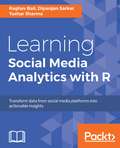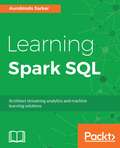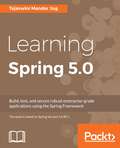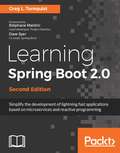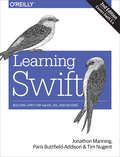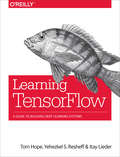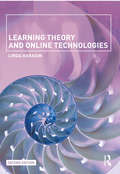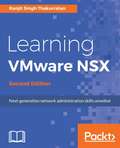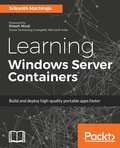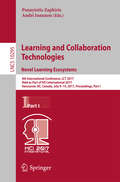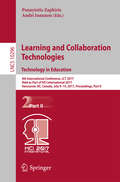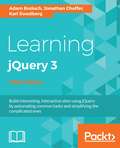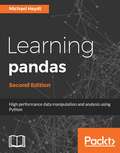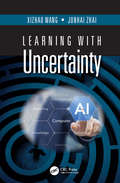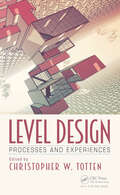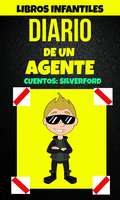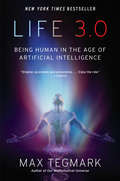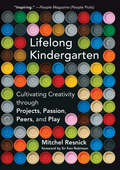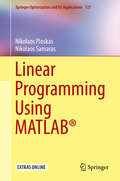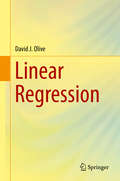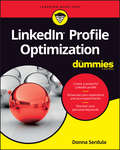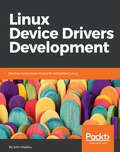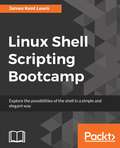- Table View
- List View
Learning Social Media Analytics with R
by Raghav Bali Dipanjan Sarkar Tushar SharmaTap into the realm of social media and unleash the power of analytics for data-driven insights using R About This Book • A practical guide written to help leverage the power of the R eco-system to extract, process, analyze, visualize and model social media data • Learn about data access, retrieval, cleaning, and curation methods for data originating from various social media platforms. • Visualize and analyze data from social media platforms to understand and model complex relationships using various concepts and techniques such as Sentiment Analysis, Topic Modeling, Text Summarization, Recommendation Systems, Social Network Analysis, Classification, and Clustering. Who This Book Is For It is targeted at IT professionals, Data Scientists, Analysts, Developers, Machine Learning Enthusiasts, social media marketers and anyone with a keen interest in data, analytics, and generating insights from social data. Some background experience in R would be helpful, but not necessary, since this book is written keeping in mind, that readers can have varying levels of expertise. What You Will Learn • Learn how to tap into data from diverse social media platforms using the R ecosystem • Use social media data to formulate and solve real-world problems • Analyze user social networks and communities using concepts from graph theory and network analysis • Learn to detect opinion and sentiment, extract themes, topics, and trends from unstructured noisy text data from diverse social media channels • Understand the art of representing actionable insights with effective visualizations • Analyze data from major social media channels such as Twitter, Facebook, Flickr, Foursquare, Github, StackExchange, and so on • Learn to leverage popular R packages such as ggplot2, topicmodels, caret, e1071, tm, wordcloud, twittR, Rfacebook, dplyr, reshape2, and many more In Detail The Internet has truly become humongous, especially with the rise of various forms of social media in the last decade, which give users a platform to express themselves and also communicate and collaborate with each other. This book will help the reader to understand the current social media landscape and to learn how analytics can be leveraged to derive insights from it. This data can be analyzed to gain valuable insights into the behavior and engagement of users, organizations, businesses, and brands. It will help readers frame business problems and solve them using social data. The book will also cover several practical real-world use cases on social media using R and its advanced packages to utilize data science methodologies such as sentiment analysis, topic modeling, text summarization, recommendation systems, social network analysis, classification, and clustering. This will enable readers to learn different hands-on approaches to obtain data from diverse social media sources such as Twitter and Facebook. It will also show readers how to establish detailed workflows to process, visualize, and analyze data to transform social data into actionable insights. Style and approach This book follows a step-by-step approach with detailed strategies for understanding, extracting, analyzing, visualizing, and modeling data from several major social network platforms such as Facebook, Twitter, Foursquare, Flickr, Github, and StackExchange. The chapters cover several real-world use cases and leverage data science, machine learning, network analysis, and graph theory concepts along with the R ecosystem, including popular packages such as ggplot2, caret,dplyr, topicmodels, tm, and so on.
Learning Spark SQL
by Aurobindo SarkarDesign, implement, and deliver successful streaming applications, machine learning pipelines and graph applications using Spark SQL API About This Book • Learn about the design and implementation of streaming applications, machine learning pipelines, deep learning, and large-scale graph processing applications using Spark SQL APIs and Scala. • Learn data exploration, data munging, and how to process structured and semi-structured data using real-world datasets and gain hands-on exposure to the issues and challenges of working with noisy and "dirty" real-world data. • Understand design considerations for scalability and performance in web-scale Spark application architectures. Who This Book Is For If you are a developer, engineer, or an architect and want to learn how to use Apache Spark in a web-scale project, then this is the book for you. It is assumed that you have prior knowledge of SQL querying. A basic programming knowledge with Scala, Java, R, or Python is all you need to get started with this book. What You Will Learn • Familiarize yourself with Spark SQL programming, including working with DataFrame/Dataset API and SQL • Perform a series of hands-on exercises with different types of data sources, including CSV, JSON, Avro, MySQL, and MongoDB • Perform data quality checks, data visualization, and basic statistical analysis tasks • Perform data munging tasks on publically available datasets • Learn how to use Spark SQL and Apache Kafka to build streaming applications • Learn key performance-tuning tips and tricks in Spark SQL applications • Learn key architectural components and patterns in large-scale Spark SQL applications In Detail In the past year, Apache Spark has been increasingly adopted for the development of distributed applications. Spark SQL APIs provide an optimized interface that helps developers build such applications quickly and easily. However, designing web-scale production applications using Spark SQL APIs can be a complex task. Hence, understanding the design and implementation best practices before you start your project will help you avoid these problems. This book gives an insight into the engineering practices used to design and build real-world, Spark-based applications. The book's hands-on examples will give you the required confidence to work on any future projects you encounter in Spark SQL. It starts by familiarizing you with data exploration and data munging tasks using Spark SQL and Scala. Extensive code examples will help you understand the methods used to implement typical use-cases for various types of applications. You will get a walkthrough of the key concepts and terms that are common to streaming, machine learning, and graph applications. You will also learn key performance-tuning details including Cost Based Optimization (Spark 2.2) in Spark SQL applications. Finally, you will move on to learning how such systems are architected and deployed for a successful delivery of your project. Style and approach This book is a hands-on guide to designing, building, and deploying Spark SQL-centric production applications at scale.
Learning Spring 5.0
by Tejaswini Mandar JogBuild, test, and secure robust enterprise-grade applications using the Spring Framework About This Book • Build an enterprise application throughout the book that communicates with a microservice • Define and inject dependencies into your objects using the IoC container • Make use of Spring's reactive features including tools and implement a reactive Spring MVC application Who This Book Is For This book is for Java developers who want to make use of the Spring framework to simplify their programming needs. What You Will Learn • Get to know the basics of Spring development and gain fundamental knowledge about why and where to use Spring Framework • Explore the power of Beans using Dependency Injection, wiring, and Spring Expression Language • Implement and integrate a persistent layer in your application and also integrate an ORM such as Hibernate • Understand how to manage cross-cutting with logging mechanism, transaction management, and more using Aspect-oriented programming • Explore Spring MVC and know how to handle requesting data and presenting the response back to the user • Get to grips with the integration of RESTful APIs and Messaging with WebSocket and STOMP • Master Reactive Programming using Spring MVC to handle non-blocking streams In Detail Spring is the most widely used framework for Java programming and with its latest update to 5.0, the framework is undergoing massive changes. Built to work with both Java 8 and Java 9, Spring 5.0 promises to simplify the way developers write code, while still being able to create robust, enterprise applications. If you want to learn how to get around the Spring framework and use it to build your own amazing applications, then this book is for you. Beginning with an introduction to Spring and setting up the environment, the book will teach you in detail about the Bean life cycle and help you discover the power of wiring for dependency injection. Gradually, you will learn the core elements of Aspect-Oriented Programming and how to work with Spring MVC and then understand how to link to the database and persist data configuring ORM, using Hibernate. You will then learn how to secure and test your applications using the Spring-test and Spring-Security modules. At the end, you will enhance your development skills by getting to grips with the integration of RESTful APIs, building microservices, and doing reactive programming using Spring, as well as messaging with WebSocket and STOMP. Style and approach Filled with examples, this tutorial-based book will help you gain all the knowledge you need to start producing enterprise-grade applications with Spring.
Learning Spring Boot 2.0 - Second Edition: Simplify the development of lightning fast applications based on microservices and reactive programming
by Greg L. TurnquistUse Spring Boot to build lightning-fast apps About This Book • Get up to date with the defining characteristics of Spring Boot 2.0 in Spring Framework 5 • Learn to perform Reactive programming with SpringBoot • Learn about developer tools, AMQP messaging, WebSockets, security, MongoDB data access, REST, and more Who This Book Is For This book is designed for both novices and experienced Spring developers. It will teach you how to override Spring Boot's opinions and frees you from the need to define complicated configurations. What You Will Learn • Create powerful, production-grade applications and services with minimal fuss • Support multiple environments with one artifact, and add production-grade support with features • Find out how to tweak your apps through different properties • Use custom metrics to track the number of messages published and consumed • Enhance the security model of your apps • Make use of reactive programming in Spring Boot • Build anything from lightweight unit tests to fully running embedded web container integration tests In Detail Spring Boot provides a variety of features that address today's business needs along with today's scalable requirements. In this book, you will learn how to leverage powerful databases and Spring Boot's state-of-the-art WebFlux framework. This practical guide will help you get up and running with all the latest features of Spring Boot, especially the new Reactor-based toolkit. The book starts off by helping you build a simple app, then shows you how to bundle and deploy it to the cloud. From here, we take you through reactive programming, showing you how to interact with controllers and templates and handle data access. Once you're done, you can start writing unit tests, slice tests, embedded container tests, and even autoconfiguration tests. We go into detail about developer tools, AMQP messaging, WebSockets, security, and deployment. You will learn how to secure your application using both routes and method-based rules. By the end of the book, you'll have built a social media platform from which to apply the lessons you have learned to any problem. If you want a good understanding of building scalable applications using the core functionality of Spring Boot, this is the book for you. Style and approach This book takes a tutorial-based approach to teach you all you need to know to get up and running with the latest version of Spring Boot. Filled with examples, you will gain hands-on experience of every area that Spring tackles.
Learning Swift: Building Apps for macOS, iOS, and Beyond (2nd Edition)
by Paris Buttfield-Addison Tim Nugent Jon ManningGet valuable hands-on experience with Swift 3, the latest version of Apple’s programming language. With this practical guide, skilled programmers with little or no knowledge of Apple development will learn how to code with Swift 3 by developing three complete, tightly linked versions of the Notes application for the OS X, iOS, and watchOS platforms.In the process, you’ll learn Swift’s fundamentals, including its syntax and features, along with the basics of the Cocoa, CocoaTouch, and WatchKit frameworks. This book teaches you how to use common design patterns for Swift, how to structure an application for Apple’s platforms, and how to submit working apps to the App Store.Divided into four distinct parts, this book includes: Swift 2 basics: Learn Swift’s basic building blocks and features for object-oriented development; OS X app development: Set up the document model, build out features, and sync data with iCloud; iOS app development: Use multimedia, contacts, location, notifications, and iCloud files to build a fully featured iOS Notes app; Advanced app extensions: Build an Apple Watch app, and learn how to debug, monitor, and test all three of your Swift apps
Learning TensorFlow: A Guide to Building Deep Learning Systems
by Itay Lieder Tom Hope Yehezkel S. ResheffRoughly inspired by the human brain, deep neural networks trained with large amounts of data can solve complex tasks with unprecedented accuracy. This practical book provides an end-to-end guide to TensorFlow, the leading open source software library that helps you build and train neural networks for computer vision, natural language processing (NLP), speech recognition, and general predictive analytics.Authors Tom Hope, Yehezkel Resheff, and Itay Lieder provide a hands-on approach to TensorFlow fundamentals for a broad technical audience—from data scientists and engineers to students and researchers. You’ll begin by working through some basic examples in TensorFlow before diving deeper into topics such as neural network architectures, TensorBoard visualization, TensorFlow abstraction libraries, and multithreaded input pipelines. Once you finish this book, you’ll know how to build and deploy production-ready deep learning systems in TensorFlow.Get up and running with TensorFlow, rapidly and painlesslyLearn how to use TensorFlow to build deep learning models from the ground upTrain popular deep learning models for computer vision and NLPUse extensive abstraction libraries to make development easier and fasterLearn how to scale TensorFlow, and use clusters to distribute model trainingDeploy TensorFlow in a production setting
Learning Theory and Online Technologies
by Linda HarasimLearning Theory and Online Technologies offers a powerful overview of the current state of online learning, the foundations of its historical roots and growth, and a framework for distinguishing between the major approaches to online learning. It addresses pedagogy (how to design an effective online environment for learning), evaluation (how to know that students are learning), and history (how past research can guide successful online teaching and learning outcomes). An ideal textbook for undergraduate Education and Communication programs as well as Educational Technology Masters, Ph.D., and Certificate programs, Learning Theory and Online Technologies provides a synthesis of the key advances in online education learning theory and the key frameworks of research, and clearly links theory and research to successful learning practice. This revised second edition updates data on digital media adoption globally, adds a new chapter on connectivism as a learning theory, and updates the chapter on online collaborative learning, renaming the theory as collaborativism and considering the challenges that arise with the growth of artificial intelligence.
Learning VMware NSX, Second Edition
by Ranjit Singh ThakurratanVMware NSX is a platform for the software-defined data center. The book allows you a thorough understanding of implementing Software defined networks using VMware’s NSX. You will get a brief overview of the NSX Core Components NSX’s basic architecture. Once you are familiar with everything, you will get to know how to deploy various NSX features. Furthermore, you will understand how to manage and monitor NSX and its associated services and features.
Learning Windows Server Containers
by Srikanth MachirajuBuild, package, and deploy applications as easily manageable and shippable containers. About This Book • Discover the secret to building highly portable apps that run on any machine with Windows Server 2016 anywhere, from laptops, desktop servers, and public or private clouds, without any changes to the code • Build your company cost-effective, container-based apps that support large-scale, virtual cloud environments • The most up-to-date help on the market, offering developers expert guidance in building and shipping high-quality apps, and also helping admins create infrastructure that's simple to maintain Who This Book Is For This book is for application developers with a basic programming knowledge of C#, ASP.NET, and PowerShell. IT Administrators or DevOps engineers with basic PowerShell experience can benefit by extending their learning to use PowerShell to manage containers on Windows environments and use additional management tools. What You Will Learn • Build and deploy ASP.NET web applications as Windows Containers on Windows 10 (Desktop) and Azure using Visual Studio 2015, Docker, and PowerShell • Build and manage custom images using Windows Server Core base OS image and Docker CLI, publish images to Docker, tag images, author Docker files, and so on • Create enterprise-scale, production-grade container environments using Redis Cache containers and SQL Server containers with storage volumes, set up custom container networks, continuous integration, and deployment pipelines using VSTS, Azure, and Git • Deploy a composite container environment using Docker Compose on Windows • Learn to build applications using Microsoft's thinnest server platform - Nano Servers. Build custom Nano Server images and Nano Containers using Windows PowerShell and configure using PowerShell Core, DSC In Detail Windows Server Containers are independent, isolated, manageable and portable application environments which are light weight and shippable. Decomposing your application into smaller manageable components or MicroServices helps in building scalable and distributed application environments. Windows Server Containers have a significant impact on application developers, development operations (DevOps) and infrastructure management teams. Applications can be built, shipped and deployed in a fast-paced manner on an easily manageable and updatable environment. Learning Windows Server Containers teaches you to build simple to advanced production grade container based application using Asp.Net Core, Visual Studio, Azure, Docker and PowerShell technologies. The book teaches you to build and deploy simple web applications as Windows and Hyper-V containers on Windows 10 and Windows Server 2016 on Azure. You will learn to build on top of Windows Container Base OS Images, integrate with existing images from Docker Hub, create custom images and publish to Hub. You will also learn to work with storage containers built using Volumes and SQL Server as container, create and configure custom networks, integrate with Redis Cache containers, configure continuous integration and deployment pipelines using VSTS and Git Repository. Further you can also learn to manage resources for a container, setting up monitoring and diagnostics, deploy composite container environments using Docker Compose on Windows and manage container clusters using Docker Swarm. The last chapter of the book focuses on building applications using Microsoft's new and thinnest server platform – Nano Servers. Style and approach This hands-on tutorial helps you get started with Windows Server containers, the new trend in the container market. This example-driven guide is packed with real-world scenarios of Windows Server containers in production environments.
Learning and Collaboration Technologies. Novel Learning Ecosystems
by Panayiotis Zaphiris Andri IoannouThe two-volume set LNCS 10295 and 10296 constitute the refereed proceedings of the 4th International Conference on Learning and Collaboration Technologies, LCT 2017, held as part of the 19th International Conference on Human-Computer Interaction, HCII 2017, in Vancouver, BC, Canada, in July 2017, in conjunction with 15 thematically similar conferences. The 1228 papers presented at the HCII 2017 conferences were carefully reviewed and selected from 4340 submissions.The papers cover the entire field of human-computer interaction, addressing major advances in knowledge and effective use of computers in a variety of application areas. The papers included in this volume are organized in the following topical sections: multimodal and natural interaction for learning; learning and teaching ecosystems; e-learning, social media and MOOCs; beyond the classroom; and games and gamification for learning.
Learning and Collaboration Technologies. Technology in Education
by Panayiotis Zaphiris Andri IoannouThe two-volume set LNCS 10295 and 10296 constitute the refereed proceedings of the 4th International Conference on Learning and Collaboration Technologies, LCT 2017, held as part of the 19th International Conference on Human-Computer Interaction, HCII 2017, in Vancouver, BC, Canada, in July 2017, in conjunction with 15 thematically similar conferences. The 1228 papers presented at the HCII 2017 conferences were carefully reviewed and selected from 4340 submissions.The papers cover the entire field of human-computer interaction, addressing major advances in knowledge and effective use of computers in a variety of application areas. The papers included in this volume are organized in the following topical sections: STEM education; diversity in learning; learning analytics; and improving the learning and collaboration experience.The chapter 'The Quality of MOOCs: How to Improve the Design of Open Education and Online Courses for Learners?' is Open Access under a CC BY 4.0 license.
Learning jQuery 3 - Fifth Edition
by Adam Boduch Karl Swedberg Jonathan ChafferCreate efficient and smart web applications with jQuery 3.0 using this step-by-step practical tutorial About This Book • Create a fully featured and responsive client-side application using jQuery • Explore all the latest features of jQuery 3.0 and code examples updated to reflect modern JavaScript environments • Develop high performance interactive pages Who This Book Is For This book is ideal for client-side JavaScript developers. You do need to have any previous experience with jQuery, although basic JavaScript programming knowledge is necessary. What You Will Learn • Create custom interactive elements for your web designs • Find out how to create the best user interface for your web applications • Use selectors in a variety of ways to get anything you want from a page when you need it • Master events to bring your web pages to life • Add flair to your actions with a variety of different animation effects • Discover the latest features available in jQuery with the latest update of this incredibly popular title • Using jQuery npm Packages In Detail If you are a web developer and want to create web applications that look good, are efficient, have rich user interfaces, and integrate seamlessly with any backend using AJAX, then this book is the ideal match for you. We'll show you how you can integrate jQuery 3.0 into your web pages, avoid complex JavaScript code, create brilliant animation effects for your web applications, and create a flawless app. We start by configuring and customising the jQuery environment, and getting hands-on with DOM manipulation. Next, we'll explore event handling advanced animations, creating optimised user interfaces, and building useful third-party plugins. Also, we'll learn how to integrate jQuery with your favourite back-end framework. Moving on, we'll learn how the ECMAScript 6 features affect your web development process with jQuery. we'll discover how to use the newly introduced JavaScript promises and the new animation API in jQuery 3.0 in great detail, along with sample code and examples. By the end of the book, you will be able to successfully create a fully featured and efficient single page web application and leverage all the new features of jQuery 3.0 effectively. Style and approach Create efficient client-side apps that look great and run seamlessly across all devices with this step-by-step practical guide. There are illustrative examples for those who need extra help to get started with jQuery web development.
Learning pandas - Second Edition
by Michael HeydtGet to grips with pandas—a versatile and high-performance Python library for data manipulation, analysis, and discovery About This Book • Get comfortable using pandas and Python as an effective data exploration and analysis tool • Explore pandas through a framework of data analysis, with an explanation of how pandas is well suited for the various stages in a data analysis process • A comprehensive guide to pandas with many of clear and practical examples to help you get up and using pandas Who This Book Is For This book is ideal for data scientists, data analysts, Python programmers who want to plunge into data analysis using pandas, and anyone with a curiosity about analyzing data. Some knowledge of statistics and programming will be helpful to get the most out of this book but not strictly required. Prior exposure to pandas is also not required. What You Will Learn • Understand how data analysts and scientists think about of the processes of gathering and understanding data • Learn how pandas can be used to support the end-to-end process of data analysis • Use pandas Series and DataFrame objects to represent single and multivariate data • Slicing and dicing data with pandas, as well as combining, grouping, and aggregating data from multiple sources • How to access data from external sources such as files, databases, and web services • Represent and manipulate time-series data and the many of the intricacies involved with this type of data • How to visualize statistical information • How to use pandas to solve several common data representation and analysis problems within finance In Detail You will learn how to use pandas to perform data analysis in Python. You will start with an overview of data analysis and iteratively progress from modeling data, to accessing data from remote sources, performing numeric and statistical analysis, through indexing and performing aggregate analysis, and finally to visualizing statistical data and applying pandas to finance. With the knowledge you gain from this book, you will quickly learn pandas and how it can empower you in the exciting world of data manipulation, analysis and science. Style and approach • Step-by-step instruction on using pandas within an end-to-end framework of performing data analysis • Practical demonstration of using Python and pandas using interactive and incremental examples
Learning with Uncertainty
by Xizhao Wang Junhai ZhaiLearning with uncertainty covers a broad range of scenarios in machine learning, this book mainly focuses on: (1) Decision tree learning with uncertainty, (2) Clustering under uncertainty environment, (3) Active learning based on uncertainty criterion, and (4) Ensemble learning in a framework of uncertainty. The book starts with the introduction to uncertainty including randomness, roughness, fuzziness and non-specificity and then comprehensively discusses a number of key issues in learning with uncertainty, such as uncertainty representation in learning, the influence of uncertainty on the performance of learning system, the heuristic design with uncertainty, etc. <P><P>Most contents of the book are our research results in recent decades. The purpose of this book is to help the readers to understand the impact of uncertainty on learning processes. It comes with many examples to facilitate understanding. The book can be used as reference book or textbook for researcher fellows, senior undergraduates and postgraduates majored in computer science and technology, applied mathematics, automation, electrical engineering, etc.
Level Design: Processes and Experiences
by Christopher W. TottenIn this book, veteran game developers, academics, journalists, and others provide their processes and experiences with level design. Each provides a unique perspective representing multiple steps of the process for interacting with and creating game levels – experiencing levels, designing levels, constructing levels, and testing levels. These diverse perspectives offer readers a window into the thought processes that result in memorable open game worlds, chilling horror environments, computer-generated levels, evocative soundscapes, and many other types of gamespaces. This collection invites readers into the minds of professional designers as they work and provides evergreen topics on level design and game criticism to inspire both new and veteran designers. Key Features: Learn about the processes of experienced developers and level designers in their own words Discover best-practices for creating levels for persuasive play and designing collaboratively Offers analysis methods for better understanding game worlds and how they function in response to gameplay Find your own preferred method of level design by learning the processes of multiple industry veterans
Libros Infantiles: Silverford)
by Alex Anderson Nicol Pizarro¿Te gusta Silverford? El mundo que conocemos va a cambiar para Siempre. El Señor Oscuro está a punto de liberar el cubo cósmico, la fuente de energía para todo el universo. Ahora el agente Jack, Steve y Notch deberán proteger el mundo de Silverford. Libro 1: La saga del cubo cósmico – La Tierra Misteriosa: Esta es la primera parte de las series del Agente de Silverford. Jack es elegido por Notch para una misión extremadamente secreta llamada “Proyecto Z”. Esta misión es muy peligrosa y no hay seguridad de que sea exitosa, pero la misión es esencial para el futuro del Mundo de Silverford. En esta saga, serán revelados secretos raros y oscuros de Silverford. Así que, ¿qué estás esperando? Libro 2: La saga del cubo cósmico – El valle de la Muerte: Esta es la segunda parte del “Diario de un Agente de Silverford”. En este libro seguimos en donde nos quedamos en la primera parte. Jack y su equipo enfrentan obstáculos y callejones sin salida pero continúan. Esta es la continuación de uno de los libros más controversiales e impresionantes jamás escritos sobre Silverford. Se revelaron muchos secretos en el primer libro y muchos se revelarán en este. Así que ¡A leer! Libro 3: La saga del cubo cósmico – El secreto de Notch: Esta es la tercera parte del “Diario de un Agente de Silverford”. Las aventuras de Jack se vuelven más peligrosas. El “proyecto Z” es cada vez más misterioso. Entérate cómo Jack y su equipo experimentan diferentes obstáculos. Giros inésperados te mantendrán en suspenso queriendo leer más. Libro 4: El cubo cósmico - La batalla del Oscuro: La saga del Agente de Silverford continúa en esta cuarta entrega, la más impresionante de Silverford jamás escrita. Las cosas toman un giro inesperado después de la llegada de una figura encapuchada. ¿Quién es? En este libro, resolverás este misterio y muchos más. ¿Serán ver
Life 3.0: Being Human in the Age of Artificial Intelligence
by Max TegmarkNew York Times Best SellerHow will Artificial Intelligence affect crime, war, justice, jobs, society and our very sense of being human? The rise of AI has the potential to transform our future more than any other technology—and there&’s nobody better qualified or situated to explore that future than Max Tegmark, an MIT professor who&’s helped mainstream research on how to keep AI beneficial. How can we grow our prosperity through automation without leaving people lacking income or purpose? What career advice should we give today&’s kids? How can we make future AI systems more robust, so that they do what we want without crashing, malfunctioning or getting hacked? Should we fear an arms race in lethal autonomous weapons? Will machines eventually outsmart us at all tasks, replacing humans on the job market and perhaps altogether? Will AI help life flourish like never before or give us more power than we can handle? What sort of future do you want? This book empowers you to join what may be the most important conversation of our time. It doesn&’t shy away from the full range of viewpoints or from the most controversial issues—from superintelligence to meaning, consciousness and the ultimate physical limits on life in the cosmos.
Lifelong Kindergarten: Cultivating Creativity through Projects, Passion, Peers, and Play (The\mit Press Ser.)
by Mitchel ResnickHow lessons from kindergarten can help everyone develop the creative thinking skills needed to thrive in today's society.In kindergartens these days, children spend more time with math worksheets and phonics flashcards than building blocks and finger paint. Kindergarten is becoming more like the rest of school. In Lifelong Kindergarten, learning expert Mitchel Resnick argues for exactly the opposite: the rest of school (even the rest of life) should be more like kindergarten. To thrive in today's fast-changing world, people of all ages must learn to think and act creatively—and the best way to do that is by focusing more on imagining, creating, playing, sharing, and reflecting, just as children do in traditional kindergartens.Drawing on experiences from more than thirty years at MIT's Media Lab, Resnick discusses new technologies and strategies for engaging young people in creative learning experiences. He tells stories of how children are programming their own games, stories, and inventions (for example, a diary security system, created by a twelve-year-old girl), and collaborating through remixing, crowdsourcing, and large-scale group projects (such as a Halloween-themed game called Night at Dreary Castle, produced by more than twenty kids scattered around the world). By providing young people with opportunities to work on projects, based on their passions, in collaboration with peers, in a playful spirit, we can help them prepare for a world where creative thinking is more important than ever before.
Lighting for Animation: The Art of Visual Storytelling
by Jasmine Katatikarn Michael TanzilloLighting for Animation is designed with one goal in mind - to make you a better artist. Over the course of the book, Jasmine Katatikarn and Michael Tanzillo (Senior Lighting TDs, Blue Sky Studios) will train your eye to analyze your work more critically, and teach you approaches and techniques to improve your craft. Focusing on the main philosophies and core concepts utilized by industry professionals, this book builds the foundation for a successful career as a lighting artist in visual effects and computer animation. Inside you’ll find in-depth instruction on: • Creating mood and storytelling through lighting • Using light to create visual shaping • Directing the viewer’s eye with light and color • Gathering and utilizing reference images • Successfully lighting and rendering workflows • Render layers and how they can be used most effectively • Specific lighting scenarios, including character lighting, environment lighting, and lighting an animated sequence • Material properties and their work with lighting • Compositing techniques essential for a lighter • A guide on how to start your career and achieve success as a lighting artist This book is not designed to teach software packages—there are websites, instructional manuals, online demos, and traditional courses available to teach you how to operate specific computer programs. That type of training will teach you how to create an image; this book will teach you the technical skills you need to make that image beautiful. Key Features Stunning examples from a variety of films serve to inspire and inform your creative choices. Unique approach focuses on using lighting as a storytelling tool, rather than just telling you which buttons to press. Comprehensive companion website contains lighting exercises, assets, challenges, and further resources to help you expand your skillset.
Linear Programming Using MATLAB® (Springer Optimization and Its Applications #127)
by Nikolaos Ploskas Nikolaos SamarasThis book offers a theoretical and computational presentation of a variety of linear programming algorithms and methods with an emphasis on the revised simplex method and its components. A theoretical background and mathematical formulation is included for each algorithm as well as comprehensive numerical examples and corresponding MATLAB#65533; code. The MATLAB#65533; implementations presented in this book are sophisticated and allow users to find solutions to large-scale benchmark linear programs. Each algorithm is followed by a computational study on benchmark problems that analyze the computational behavior of the presented algorithms. As a solid companion to existing algorithmic-specific literature, this book will be useful to researchers, scientists, mathematical programmers, and students with a basic knowledge of linear algebra and calculus. The clear presentation enables the reader to understand and utilize all components of simplex-type methods, such as presolve techniques, scaling techniques, pivoting rules, basis update methods, and sensitivity analysis.
Linear Regression
by David J. OliveThis text covers both multiple linear regression and some experimental design models. The text uses the response plot to visualize the model and to detect outliers, does not assume that the error distribution has a known parametric distribution, develops prediction intervals that work when the error distribution is unknown, suggests bootstrap hypothesis tests that may be useful for inference after variable selection, and develops prediction regions and large sample theory for the multivariate linear regression model that has m response variables. A relationship between multivariate prediction regions and confidence regions provides a simple way to bootstrap confidence regions. These confidence regions often provide a practical method for testing hypotheses. There is also a chapter on generalized linear models and generalized additive models. There are many R functions to produce response and residual plots, to simulate prediction intervals and hypothesis tests, to detect outliers, and to choose response transformations for multiple linear regression or experimental design models.This text is for graduates and undergraduates with a strong mathematical background. The prerequisites for this text are linear algebra and a calculus based course in statistics.
LinkedIn Profile Optimization For Dummies
by Donna SerdulaOptimize your LinkedIn profile--and get results Your LinkedIn profile is essentially a platform to shape how others see you, highlight your abilities, products, or services, and explain how your work impacts lives. Yet many people simply copy and paste their resume and expect job offers and networking opportunities to start rolling in--but that isn't how it works. LinkedIn Profile Optimization For Dummies shows you how to create a profile that enhances your personal brand, controls how others see you, and shapes a successful future for your career. Whether your goal is job search, branding, reputation management, or sales, people are Googling you--and your LinkedIn profile is more often than not their first point of contact. With a focus on who you are, the value you deliver, and the culture you cultivate, the profile you'll create with the help of this guide will make that first connection a positive one--giving you a better chance to see results. Create a powerful LinkedIn profile Discover your personal keywords Showcase your experience and accomplishments Be seen on the world's largest professional social network You never get a second chance to make a great first impression, and LinkedIn Profile Optimization For Dummies helps to ensure you're presenting yourself in the best possible light.
Linux Device Drivers Development
by John MadieuLearn to develop customized device drivers for your embedded Linux system About This Book • Learn to develop customized Linux device drivers • Learn the core concepts of device drivers such as memory management, kernel caching, advanced IRQ management, and so on. • Practical experience on the embedded side of Linux Who This Book Is For This book will help anyone who wants to get started with developing their own Linux device drivers for embedded systems. Embedded Linux users will benefit highly from this book. This book covers all about device driver development, from char drivers to network device drivers to memory management. What You Will Learn • Use kernel facilities to develop powerful drivers • Develop drivers for widely used I2C and SPI devices and use the regmap API • Write and support devicetree from within your drivers • Program advanced drivers for network and frame buffer devices • Delve into the Linux irqdomain API and write interrupt controller drivers • Enhance your skills with regulator and PWM frameworks • Develop measurement system drivers with IIO framework • Get the best from memory management and the DMA subsystem • Access and manage GPIO subsystems and develop GPIO controller drivers In Detail Linux kernel is a complex, portable, modular and widely used piece of software, running on around 80% of servers and embedded systems in more than half of devices throughout the World. Device drivers play a critical role in how well a Linux system performs. As Linux has turned out to be one of the most popular operating systems used, the interest in developing proprietary device drivers is also increasing steadily. This book will initially help you understand the basics of drivers as well as prepare for the long journey through the Linux Kernel. This book then covers drivers development based on various Linux subsystems such as memory management, PWM, RTC, IIO, IRQ management, and so on. The book also offers a practical approach on direct memory access and network device drivers. By the end of this book, you will be comfortable with the concept of device driver development and will be in a position to write any device driver from scratch using the latest kernel version (v4.13 at the time of writing this book). Style and approach A set of engaging examples to develop Linux device drivers
Linux Shell Scripting Bootcamp
by James Kent LewisA quick and straightforward approach to writing shell scripts to accomplish different types of tasks on a Linux system. About This Book • Understand expressions and variables and how to use them practically • Familiarize yourself with the various text filtering tools available in Linux • A fast-paced and concise guide that gets you well versed with linux shell scripting. Who This Book Is For This book is for both GNU/Linux users who want to do amazing things with the shell and for advanced users looking for ways to make their lives with the shell more productive. What You Will Learn • Get acquainted with the basics of a shell script to serve as a refresher for more advanced topics • Learn different ways to create and run a script • Discuss the passing and verification of parameters, along with the verification of other items. • Understand the different forms of conditions and loops, and go over the sleep command in detail • Learn about different ways to handle the reporting of return codes • Create an interactive script by reading the keyboard and use subroutines and interrupts • Create scripts to perform backups and go over the use of encryption tools and checksums • Use wget and curl in scripts to get data directly from the Internet In Detail Linux Shell Scripting Bootcamp is all about learning the essentials of script creation, validating parameters, and checking for the existence of files and other items needed by the script. We will use scripts to explore iterative operations using loops and learn different types of loop statements, with their differences. Along with this, we will also create a numbered backup script for backup files. Further, you will get well-versed with how variables work on a Linux system and how they relate to scripts. You'll also learn how to create and call subroutines in a script and create interactive scripts. The most important archive commands, zip and tar, are also discussed for performing backups. Later, you will dive deeper by understanding the use of wget and curl scripts and the use of checksum and file encryption in further chapters. Finally, you will learn how to debug scripts and scripting best practices that will enable you to write a great code every time! By the end of the book, you will be able to write shell scripts that can dig data from the web and process it efficiently. Style and approach This book is all about fast and intensive learning. This means we don't waste time in helping readers get started. The new content is basically about filling in with highly-effective examples to build new things, solving problems in newer and unseen ways, and solving real-world examples.
